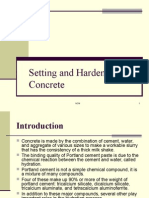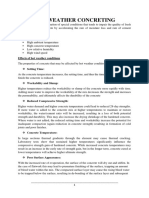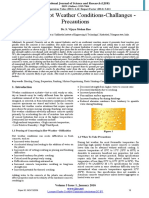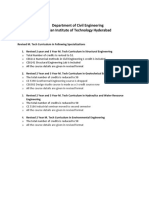Setting Time of Concrete
Setting Time of Concrete
Uploaded by
miyaeunchaeCopyright:
Available Formats
Setting Time of Concrete
Setting Time of Concrete
Uploaded by
miyaeunchaeCopyright
Available Formats
Share this document
Did you find this document useful?
Is this content inappropriate?
Copyright:
Available Formats
Setting Time of Concrete
Setting Time of Concrete
Uploaded by
miyaeunchaeCopyright:
Available Formats
TIP
#5
SETTING TIME OF CONCRETE
The practical use of concrete as a construction material depends upon the fact that it is plastic in the freshly
mixed state and subsequently becomes hard, with considerable strength. This change in its physical properties
is due to the chemical reaction between cement and water, a process known as hydration. Hydration involves
chemical changes, not just a drying out of the material. Hydration is irreversible. The reaction is gradual; first
causing a stiffening of the concrete, and then development of strength, which continues for a very long time.
Under certain ideal conditions it is probable that the concrete to increase in strength indefinitely.
Air temperature, ground temperature and weather conditions all play major roles in the rate which cement
hydrates. The setting time of concrete decreases with a rise in temperature. At low temperatures setting time
is retarded. However, when concrete is being used in times of temperature extremes, i.e. colder weather or in
the middle of summer, several admixtures may be used in the concrete mix to aid in the placement of the final
product. These admixtures are Accelerators and Retarders.
ACCELERATORS
Accelerators have been designed to significantly boost the early
setting times and increase the early age strengths of concrete.
Setting times of non accelerated concrete are significantly slower as
temperatures get colder. This obviously affects finishing times. The
action of the accelerator counters this set retardation and shortens
setting times back to what is considered a normal set time.
16
14
Consult your Allied Concrete representative for
specialised information.
0800 4 ALLIED (0800 4 225 433)
www.alliedconcrete.co.nz
Allied Concrete have endeavoured to present the best possible information.
However, it disclaims any responsibility for the application of the principles
discussed.
Std
1%
2%
12
10
8
6
4
2
8 9 10 11 12 13 14 15 16 17 18 19 20
RETARDERS
Retarders are designed for use in areas where early setting of
concrete is not preferable, ie. high ambient temperatures, long travel
times between concrete plant and job site, large slow pours to
prevent formation of cold joints etc. The chemical composition of the
retarder is formulated to temporarily stop the action of hydration,
delaying the initial set of the concrete. This delay is proportional
to the dose of the retarder used. Once the effect of the retarder
wears off initial set will take place and hardening will develop at an
accelerated rate. The two graphs below demonstrate the effects of
accelerators and retarders on the setting time of concrete.
EFFECT OF ACCELERATORS ON
CONCRETE SETTING TIME
Temperature (degrees celcius)
EFFECT OF RETARDERS ON
CONCRETE SETTING TIME
16
11
6
0.4
0.5
0.6
0.7
0.8
0.9
Dosage (% by weight of cement)
1.0
You might also like
- Hot Weather Concreting 1696843662Document3 pagesHot Weather Concreting 1696843662ashiq.arNo ratings yet
- 12 - Hot Weather ConcretingDocument2 pages12 - Hot Weather ConcretingHakan Kuruoğlu0% (1)
- CIP 12 - Hot Weather ConcretingDocument2 pagesCIP 12 - Hot Weather ConcretingSatt PaingNo ratings yet
- Hot and Cold Weather ConcretingDocument7 pagesHot and Cold Weather ConcretingFaisal Gulzar100% (1)
- CIP 12 Hot Weather ConcretingDocument2 pagesCIP 12 Hot Weather ConcretingTim_CNo ratings yet
- Cold Weather ConcretingDocument52 pagesCold Weather ConcretingSukhwinder Singh GillNo ratings yet
- Hot Weather ConcretingDocument6 pagesHot Weather Concretingharish420No ratings yet
- Hot Weather ConcretingDocument4 pagesHot Weather Concretingochiengtonny549No ratings yet
- Assignment 1 (Acmt)Document14 pagesAssignment 1 (Acmt)Jeevan kumar GounipalliNo ratings yet
- 12pr PDFDocument2 pages12pr PDFAlban TabakuNo ratings yet
- Extreme Weather Concreting and Chemical Admixtures in ConcreteDocument8 pagesExtreme Weather Concreting and Chemical Admixtures in ConcretetyashraniNo ratings yet
- CMDC Cold Weather ConstructionDocument4 pagesCMDC Cold Weather ConstructionJoseph DavisNo ratings yet
- Cold Weather Concrete TipsDocument2 pagesCold Weather Concrete TipsArmenak BaghdasaryanNo ratings yet
- Special Concrete (2)Document15 pagesSpecial Concrete (2)govtpolytechnicudhampurNo ratings yet
- Self Curing ConcreteDocument26 pagesSelf Curing Concretepraveenpv7No ratings yet
- Studying of Effect The High Range Water Reducer Super Plasticizer Retarding Admixture On Properties of ConcreteDocument5 pagesStudying of Effect The High Range Water Reducer Super Plasticizer Retarding Admixture On Properties of ConcreteKing MKNo ratings yet
- Plain & Reinforced Cement - 1 PBL Activity-1Document6 pagesPlain & Reinforced Cement - 1 PBL Activity-1Umair AshrafNo ratings yet
- Concrete Temperature Controlling During Mix DesignDocument4 pagesConcrete Temperature Controlling During Mix DesignabguyNo ratings yet
- Hot Weather ConcretingDocument74 pagesHot Weather ConcretingTonyBuiNo ratings yet
- Cold Weather ConcretingDocument2 pagesCold Weather ConcretingBoris DikovNo ratings yet
- Hot Weather Concreting-1Document37 pagesHot Weather Concreting-1ephNo ratings yet
- Issue 01 Hot Weather Concreting R2Document6 pagesIssue 01 Hot Weather Concreting R2Jayaprakash SrinivasanNo ratings yet
- Construction Updates: Extreme Weather ConcretingDocument8 pagesConstruction Updates: Extreme Weather Concretingzacharia MshandeteNo ratings yet
- Curing - MainDocument1 pageCuring - MainGirma JankaNo ratings yet
- Brett MIller - How Concrete Is MadeDocument5 pagesBrett MIller - How Concrete Is MadeBrett MillerNo ratings yet
- Hot Weather ConcretingDocument31 pagesHot Weather ConcretingLalitha Krishna MoorthyNo ratings yet
- Special Concreting TechnequesDocument26 pagesSpecial Concreting TechnequesParth AnajwalaNo ratings yet
- Ijciet: ©iaemeDocument10 pagesIjciet: ©iaemeIAEME PublicationNo ratings yet
- Impact of Weather Conditions On ConcretingDocument3 pagesImpact of Weather Conditions On ConcretingTahmidtuhinNo ratings yet
- CIP Cold WeatherDocument2 pagesCIP Cold WeatherGrou RiakNo ratings yet
- 10 TIPS TO SUCCESSFUL HOT WEATHER CONCRETING - Barton SupplyDocument3 pages10 TIPS TO SUCCESSFUL HOT WEATHER CONCRETING - Barton SupplyAmin ZuraiqiNo ratings yet
- Hot and Cold W. ConcreteDocument15 pagesHot and Cold W. ConcreteAyaz KhanNo ratings yet
- Setting and Hardening of ConcreteDocument30 pagesSetting and Hardening of ConcreteManjer123No ratings yet
- Module 3 - Concrete Under Extreme Environmental ConditionsDocument15 pagesModule 3 - Concrete Under Extreme Environmental Conditionsabinash choudharyNo ratings yet
- 1 Hot Weather Concreting - PDFDocument51 pages1 Hot Weather Concreting - PDFYoumna ShatilaNo ratings yet
- Draft PPT - Quality Month Traning Programe Reg. Early Strength Concrete For Dated 17th Nov-2020Document16 pagesDraft PPT - Quality Month Traning Programe Reg. Early Strength Concrete For Dated 17th Nov-2020Dwijendra ChanumoluNo ratings yet
- Cold Weather Concrete PDFDocument4 pagesCold Weather Concrete PDFyanickdouce1206No ratings yet
- Conc in Hot and Cold RegionsDocument37 pagesConc in Hot and Cold RegionsDhana ShekarNo ratings yet
- No3 Time of Set PDFDocument2 pagesNo3 Time of Set PDFdiwakar_622No ratings yet
- Masonry Technical Notes For Design and ConstructionDocument130 pagesMasonry Technical Notes For Design and Constructionv100% (5)
- 6 Hot Weather Concreting ACI 305Document61 pages6 Hot Weather Concreting ACI 305Hashiru JīpuNo ratings yet
- Stronger, Faster: by Mar Tin S. McgovernDocument3 pagesStronger, Faster: by Mar Tin S. McgovernVijay KumarNo ratings yet
- MASS CONCRETE METHOD STATEMENT - FinalDocument89 pagesMASS CONCRETE METHOD STATEMENT - FinalMichael Assefa100% (1)
- Hot Weather ConcretingDocument6 pagesHot Weather ConcretingMazharYasinNo ratings yet
- Exterior Concrete Pavement Draft 2Document1 pageExterior Concrete Pavement Draft 2nketchumNo ratings yet
- ECV 205 Tutorial AnswersDocument8 pagesECV 205 Tutorial AnswersRobertNo ratings yet
- Thesis Proposal CHAPTER IIIDocument17 pagesThesis Proposal CHAPTER IIIJonathanNo ratings yet
- Conc - Tech Lec-5Document17 pagesConc - Tech Lec-5kassawNo ratings yet
- The Boral Book of ConcreteDocument44 pagesThe Boral Book of ConcreteGustavo Steffen100% (1)
- Concreting in Extreme Weather ConditionsDocument43 pagesConcreting in Extreme Weather Conditionsmansoor azam100% (1)
- Temperature and Effect On ConcreteDocument59 pagesTemperature and Effect On ConcreteBart KwanNo ratings yet
- Hot Weather ConcretingDocument26 pagesHot Weather ConcretingSaulat JillaniNo ratings yet
- C2 Curado Del Concreto - PCADocument7 pagesC2 Curado Del Concreto - PCAJancarlo Mendoza MartínezNo ratings yet
- Concrete in Hot Weather Conditions-Challanges - Precautions: Dr. S. Vijaya Mohan RaoDocument6 pagesConcrete in Hot Weather Conditions-Challanges - Precautions: Dr. S. Vijaya Mohan RaoHussain ElarabiNo ratings yet
- CIP05-Plastic Shrinkage CrackingDocument2 pagesCIP05-Plastic Shrinkage Cracking7774R105No ratings yet
- Curing Concrete - Concrete Technology - Portland Cement Association (PCA)Document6 pagesCuring Concrete - Concrete Technology - Portland Cement Association (PCA)Jay PatelNo ratings yet
- Question No .1 Heat of HydrationDocument11 pagesQuestion No .1 Heat of Hydrationishtiaq raoNo ratings yet
- Example Ass 1 Budget & Costing 2022Document78 pagesExample Ass 1 Budget & Costing 2022Steve LiNo ratings yet
- Pavement Design IRC 37 2012Document1 pagePavement Design IRC 37 2012ashoknrNo ratings yet
- TOPIC No 1 AIRFRAME WADocument12 pagesTOPIC No 1 AIRFRAME WASamarth SNo ratings yet
- Manejadora Carrier 40RM-10pdDocument80 pagesManejadora Carrier 40RM-10pdrayravel100% (2)
- Transportation Engineering II (Lec - 3)Document9 pagesTransportation Engineering II (Lec - 3)ali hasanNo ratings yet
- FoundationsDocument1,152 pagesFoundationsLito EstimosNo ratings yet
- Fluent-Intro 14.5 L03 Turbulence&HeatTransfer&Transient PDFDocument72 pagesFluent-Intro 14.5 L03 Turbulence&HeatTransfer&Transient PDFWedye BagonkNo ratings yet
- A Review of Requirements On Ground Investigation and Load Test For Foundation Piles in SingaporeDocument72 pagesA Review of Requirements On Ground Investigation and Load Test For Foundation Piles in SingaporeChong Hong RuiNo ratings yet
- 1 1.1 General: Commercial Building For Mr. Pramod Neupane Sitapaila, Kathmandu Structural Design Summary ReportDocument31 pages1 1.1 General: Commercial Building For Mr. Pramod Neupane Sitapaila, Kathmandu Structural Design Summary ReportRoshan KejariwalNo ratings yet
- Steelwise - Does This Beam Make My Building Look Too HeavyDocument5 pagesSteelwise - Does This Beam Make My Building Look Too Heavycancery0707No ratings yet
- JURNAL PondasiDocument12 pagesJURNAL PondasiHerdy DwiyanaNo ratings yet
- Structural Design Calculation of CCT at BhimavaramDocument61 pagesStructural Design Calculation of CCT at Bhimavaramepe civilNo ratings yet
- Inspection Report 14 NDocument1 pageInspection Report 14 NAdriano CelentanoNo ratings yet
- SWD-TS-500-2000 (R 2018)Document52 pagesSWD-TS-500-2000 (R 2018)Harley SuhendarNo ratings yet
- CGM - FM Assignment 1 PDFDocument4 pagesCGM - FM Assignment 1 PDFcharlesgmartinNo ratings yet
- A History of The Development of Isotache ModelsDocument30 pagesA History of The Development of Isotache ModelsBookAncestorNo ratings yet
- Tata Structura Hollow Sections Designer Manual. - Yst 310Document163 pagesTata Structura Hollow Sections Designer Manual. - Yst 310Mike Victor86% (7)
- Block Wall - Risk AssessmentDocument19 pagesBlock Wall - Risk Assessmentfziza100% (3)
- RAM Connection Standalone CE Report - 11Document2 pagesRAM Connection Standalone CE Report - 11dineshNo ratings yet
- M-25 Mix Designs As Per Is-10262-2009Document3 pagesM-25 Mix Designs As Per Is-10262-2009burhan.kanjeta1988100% (1)
- Sediment Transport - Zhou LiuDocument75 pagesSediment Transport - Zhou LiuRahman To RicoNo ratings yet
- J Msea 2021 141504Document9 pagesJ Msea 2021 141504abdul-jaleel mohammedNo ratings yet
- Ground Characterization and Structural Analyses For Tunnel DesignDocument473 pagesGround Characterization and Structural Analyses For Tunnel Designsvs dmrNo ratings yet
- Area of Slab 21.53: Self-Weight of Slab Self-Weight of Beams Self-Weight of ColumnDocument2 pagesArea of Slab 21.53: Self-Weight of Slab Self-Weight of Beams Self-Weight of ColumnRooking Ewondo SfuutNo ratings yet
- M.Tech Curriculum ReferenceDocument32 pagesM.Tech Curriculum ReferenceMunaganti KiranNo ratings yet
- A Method For Estimating Immediate Settlement of Piles and Pile GroupsDocument16 pagesA Method For Estimating Immediate Settlement of Piles and Pile GroupsPhetole Pat RaseteloNo ratings yet
- MSE 212 Material Science Lab Experiment (3) : Tensile Test: Submitted byDocument13 pagesMSE 212 Material Science Lab Experiment (3) : Tensile Test: Submitted byRewanNo ratings yet
- Gan 2019 A Comprehensive Approach To MitigatDocument16 pagesGan 2019 A Comprehensive Approach To MitigatCharitha SeneviratneNo ratings yet
- Piping AnalysisDocument3 pagesPiping AnalysisAli YusufNo ratings yet
- Noedit Wbs PmsDocument51 pagesNoedit Wbs PmsSadraShahbaziNo ratings yet

























































































